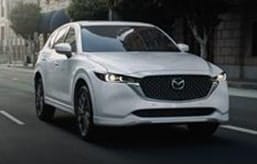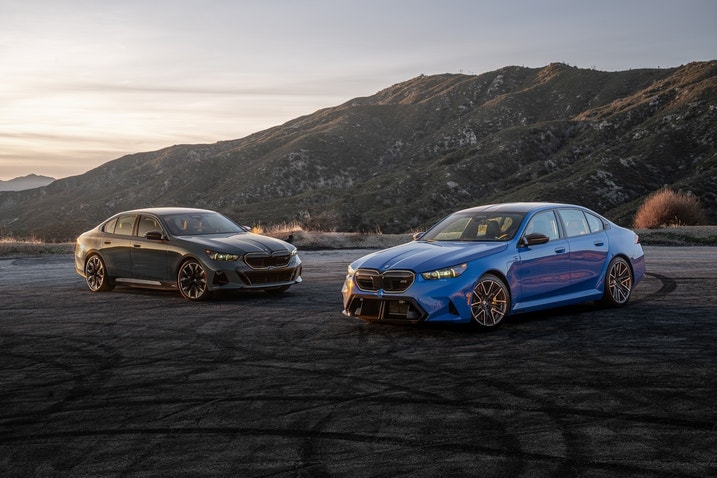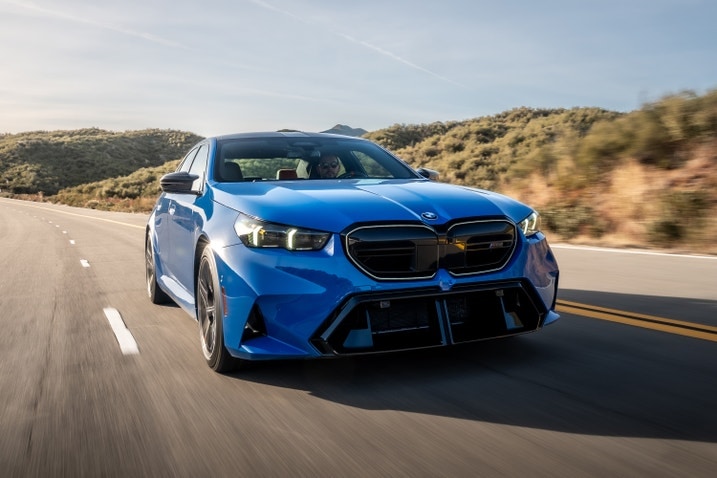- The M5 and i5 M60 are the performance bookends of the BMW 5 Series lineup.
- These sedans have similar performance figures but ultimately feel different out on the road.
- Which sedan best represents what a 5 Series should be? Read on to find out.
2025 BMW M5 vs. BMW i5 M60: Which 5 Series Is Truly Best?
Does the 5 Series thrive on EV power alone, or is the V8 still the way to go?
We aren't pitting the new BMW M5 against another hardcore rival, but a close member of its family tree, the BMW i5 M60. With the M5 getting a little electrification of its own — and not quite living up to the razor-sharp standards of its predecessors — we wondered: Which 5 Series accomplishes its particular mission better? And which one would we live with day to day?
Living with an i5 M60 in our One-Year Road Test fleet revealed that BMW's electrified 5 Series is so good, it's legitimately worth comparing to the M5. Maybe not in outright performance terms, but that’s not the question we’re here to answer. We just want to know which one of these big Bavarian sedans best executes the 5 Series formula.
You can’t talk about the new M5 without addressing the elephant in the room because, well, it is the elephant in the room. BMW shoved batteries and an electric motor into the new M5, adding almost 1,000 pounds in the process — compared to the old M5 Competition anyway. In fact, the M5 is even heavier than the completely electric i5 we have here, which has a significantly larger battery pack. We're talking 5,259 pounds to the i5’s 5,233 pounds. That might sound crazy, but our scales don’t lie.
With such similar weight specs, the M5's 127-horsepower advantage helps it pull away from the i5 M60 — but not by much. In our testing, the M5 did 0-60 mph in 3.4 seconds and finished the quarter mile in 11.2 seconds at 126.6 mph. The i5 was slower to 60 mph by just 0.1 second, though it carried a much lower trap speed through the quarter mile, logging 11.5 seconds at 122.1 mph.
On our 200-foot lateral skidpad, the M5 pulled 1.02 g, while the i5 managed 0.95 g on its EV-minded tires. The only place the M5 trails its electric sibling is in our 60-0 mph braking test. The i5 hauled itself to a stop in 104 feet; the M5 needed 118 feet. That raised a few eyebrows, and a little investigation revealed every single one of the M5's Hankook Ventus S1 Evo Z tires were scrubbed down to the wear bars when the car came in for testing. Hopefully we'll be able to retest the M5 on fresh rubber, as the results will likely be more impressive. For now, anyway, the M5's numbers carry a small asterisk.
But numbers don't tell the full story. Driving the cars back to back, the M5 is in a totally different league in terms of acceleration, grip and braking. While running in tandem on a great road, the M5 was able to pull away much quicker than the i5. The M5 could also attack corners with much more confidence while carrying more speed. The i5 is quick, to be sure, but it's limited by its low-rolling-resistance EV-friendly tires, as well as brakes that aren't nearly as thermally capable as the M5's carbon-ceramic setup. All this means you can push the M5 harder for longer, while the i5 succumbs to fade.
But is the M5 perfect? Hardly. Compared to previous M5s, you have to work much harder to extract the ferocious side of its persona. Its enormous heft is apparent as soon as you turn a wheel — this despite the steering itself being entirely bereft of feedback.
That's not to say the M5 doesn't have the right ingredients. The V8 pulls hard and revs smoothly all the way to its 7,500-rpm redline. All-wheel drive and the M-specific limited-slip differential manage traction across the rear wheels perfectly. The hybrid system has been tuned to neatly fill the gaps in the engine's powerband so the M5 always pulls hard. But even with all that brain power, this M5 just isn't as talented as its forebears.
In turn, this is what allows the i5's greatness to shine. It has a singularity of focus that the M5 has lost. In a world where EVs are far, far easier to slide by regulators, the M5 has too much to worry about all at once. It has to be efficient, have a V8, be usable on road trips, tear up a back road, control its own (considerable) mass and be fun all at once. The i5 only has to be a good luxury sedan, and it completely nails that brief.
The i5 M60 xDrive is quiet, composed and comfortable all of the time, over any kind of road surface — a stark contrast to the M5's persistently punishing ride. Those EV-specific tires are lined with foam to dial out even more road noise, and the i5's air springs are as good at controlling the sedan's mass as the mega-stiff adaptive dampers are on the M5. The whole thing coalesces around the ideals of what makes a great luxury sedan, something the M5's split personality can't do anymore.
Neither of these BMW 5 Series models is perfect, largely thanks to their shared interior ergonomics. There are almost no physical controls to speak of inside. Every button has been replaced by a touch-sensitive panel that simply opens a new menu in the center screen. Oddly, we think the i5 gets away with this better than the M5; a proper performance car is better suited for a more engaging, tactile experience.
So, which car wins? Perhaps surprisingly, it's the i5. The M5 is tied down by its predecessors, all of which have better balanced the engagement, usability and outright menacing performance we've come to expect from an M5. The i5 has no such heritage, so it can simply exist as the very best version of itself. Neither car here is bad, but for the best all-around example of what a 5 Series should be, it's the i5 M60.
Photos by Tyler Clemmensen
2025 BMW M5 vs. 2024 BMW i5 M60
Spec | 2025 BMW M5 | 2024 BMW i5 M60 |
|---|---|---|
| Engine | twin-turbo 4.0-liter V8 | N/A |
| Battery | 14.8 kWh | 84.3 kWh |
| Electric motors | 1 | 2 |
| Output | 717 hp | 593 hp |
| Torque | 738 lb-ft | 586 lb-ft |
| Driveline | all-wheel drive | all-wheel drive |
| Transmission | eight-speed automatic | single-speed automatic |
| 0-60 mph | 3.4 seconds | 3.5 seconds |
| Quarter mile | 11.2 seconds @ 126.6 mph | 11.5 seconds @ 122.1 mph |
| 60-0 mph braking | 118 feet | 104 feet |
| Lateral grip (200-foot skidpad) | 1.02 g | 0.95 g |
| Weight | 5,259 pounds | 5,233 pounds |
| EPA fuel economy | 14 mpg combined | N/A |
| Edmunds observed range | N/A | 264 miles |
| Base price | $119,500 | $85,095 |
| As-tested price | $146,225 | $95,745 |








 by
by  edited by
edited by